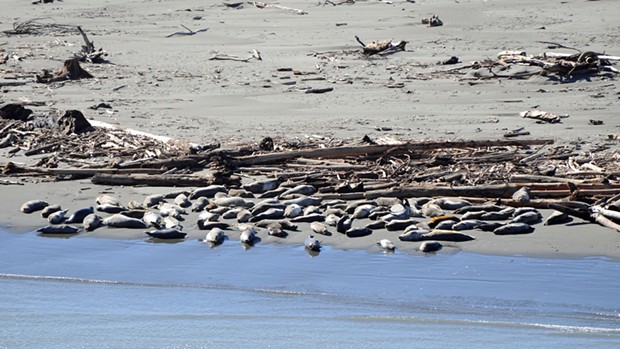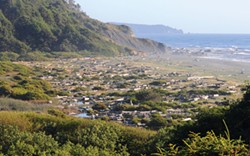[
{
"name": "Top Stories Video Pair",
"insertPoint": "7",
"component": "17087298",
"parentWrapperClass": "fdn-ads-inline-content-block",
"requiredCountToDisplay": "1"
}
]
I woke up this morning to find that I'm no longer human. I'm a beach!
I'm a dynamic beach with large surf breaking over me. The waves erode the large dune that used to be my beer belly, and when the tide recedes, the dune is replaced by a flat gravel bed. And just beyond that I can now see a large log. It's long and thick and has a tangled mass of roots at its base. I think I'll like being a beach.
In the fish and wildlife habitat business we call big logs like mine "large woody debris" or LWD. Large wood provides many important habitat functions on the beds and banks of rivers and streams, and it also plays important roles on beaches and in estuaries.
The ideal piece of habitat-forming LWD is a fat redwood tree with its root ball still attached. A piece like that may persist for many decades in one location, and it may have other lives as it gets moved around by floods and big surf. And the places you find big wood give an indication of where the water has been.
For example, an ecology professor told us that the accumulation of large wood high up on the sand spit at Dry Lagoon was deposited during the 1964 Flood. This wood provides shelter for seeds to establish, and most logs are hosts to small, wind-blasted trees and shrubs. All of this provides habitat for wildlife, and it's no wonder that this is a great place for bird watching.
After the storms of 2017, a new, large stump and root mass with barnacles on it washed up on Mad River Beach. The barnacles indicated this piece of large wood had probably been in the Mad River estuary, where it would have provided cover for fish, a perch for birds and a safe place for river otters to linger. Even harbor seals will haul out on a comfortable-looking estuary log.
I have a favorite pair of large redwood stumps on one of our local beaches. I think of them as a married couple. They were together in the same spot for at least 20 years but the storms of 2017 washed the "husband" about 100 yards to the north. It actually made me sad. An interesting thing about these semi-permanent pieces of large wood is they make it obvious how much erosion and deposition of sand occurs annually. Sometimes the "married couple" stick out of the sand 5 to 6 feet high and sometimes they are completely buried.
Unfortunately, very large wood has become scarce where it's needed most. This happened for a variety of reasons, including historic timber harvest practices, modern wood poaching and old-time, ignorant fish biologists removing wood jams to "help salmon swim upstream."
Once, while we were working on a small coastal stream, someone opined that we should remove the log jam from the beach at the mouth of the creek. I climbed down into the jam with my mask and snorkel to see how blocked it really was. I found two adult steelhead safely holding with plenty of room to swim up- or downstream when higher flows returned. Jams may look impenetrable from above, but the stream scours out plenty of space below for fish passage and protective cover.
Anyway, it's a sunny day and I feel the warmth on my new flat belly and my big log. You might like to take a walk on my beach. See what you can find. But please clean up after your dog and do not molest my large wood.
Biologist Mike Kelly (he/him) writes science-based satire as M. Sid Kelly. It's available at Eureka Books and for Kindle.
Comments
Showing 1-1 of 1
more from the author
-
Hot Tomcod Action
- Apr 18, 2024
-
Wandering Meatloaf
- Mar 7, 2024
-
Sea Palm Crime
- Jan 11, 2024
- More »

































